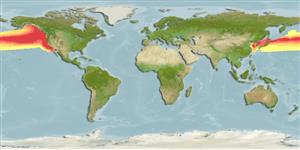Teleostei (teleosts) >
Myctophiformes (Lanternfishes) >
Myctophidae (Lanternfishes) > Myctophinae
Etymology: Tarletonbeania: Because of Tarleton H. Bean, fisrt curator of fishes in Smithsonian Institut; 1846-1916; crenularis: From the Latin crenula which means small notch - referring to the slightly scalloped edges of the scale..
More on authors: Jordan & Gilbert.
Environment: milieu / climate zone / depth range / distribution range
Ecology
Marine; bathypelagic; depth range 0 - 710 m (Ref. 6885). Deep-water; 66°N - 28°N
Eastern Pacific: southeastern Alaska to off Mexico, including the Gulf of Alaska and Bering Sea (Ref. 31442).
Size / Weight / Age
Maturity: Lm ? range ? - ? cm
Max length : 12.7 cm TL male/unsexed; (Ref. 4925)
Short description
Identification keys | Morphology | Morphometrics
Epipelagic to mesopelagic, found at the surface at night (Ref. 31442). Feed on euphausiids (Ref. 6885). Oviparous, with planktonic eggs and larvae (Ref. 31442). Lipid content is 2.1 % in fresh body weight and wax ester is, at the most, 5 % in total lipids (Ref. 9197).
Life cycle and mating behavior
Maturities | Reproduction | Spawnings | Egg(s) | Fecundities | Larvae
Hart, J.L., 1973. Pacific fishes of Canada. Bull. Fish. Res. Board Can. 180:740 p. (Ref. 6885)
IUCN Red List Status (Ref. 130435)
Threat to humans
Harmless
Human uses
Tools
Special reports
Download XML
Internet sources
Estimates based on models
Preferred temperature (Ref.
123201): 1.8 - 9.3, mean 6.2 °C (based on 129 cells).
Phylogenetic diversity index (Ref.
82804): PD
50 = 0.7500 [Uniqueness, from 0.5 = low to 2.0 = high].
Bayesian length-weight: a=0.00871 (0.00387 - 0.01962), b=3.11 (2.92 - 3.30), in cm total length, based on LWR estimates for this (Sub)family-body shape (Ref.
93245).
Trophic level (Ref.
69278): 3.1 ±0.32 se; based on food items.
Resilience (Ref.
120179): High, minimum population doubling time less than 15 months (Preliminary K or Fecundity.).
Fishing Vulnerability (Ref.
59153): Low vulnerability (10 of 100).
